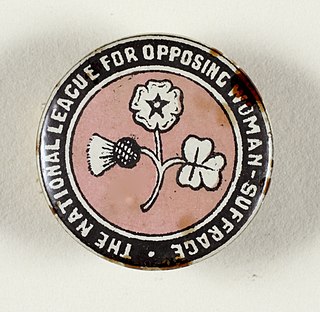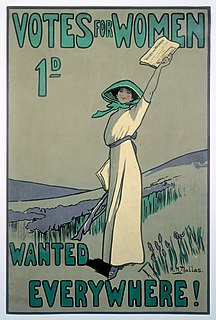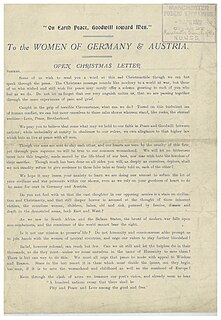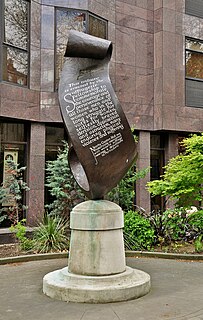
Women's suffrage is the right of women to vote in elections. Beginning in the mid-19th century, aside from the work being done by women for broad-based economic and political equality and for social reforms, women sought to change voting laws to allow them to vote. National and international organizations formed to coordinate efforts towards that objective, especially the International Woman Suffrage Alliance, as well as for equal civil rights for women.
This is an index of articles related to the issue of feminism, women's liberation, the women's movement, and women's rights.
First-wave feminism was a period of feminist activity and thought that occurred during the 19th and early 20th century throughout the Western world. It focused on legal issues, primarily on securing women's right to vote.
As in other countries, feminism in the United Kingdom seeks to establish political, social, and economic equality for women. The history of feminism in Britain dates to the very beginnings of feminism itself, as many of the earliest feminist writers and activists—such as Mary Wollstonecraft, Barbara Bodichon, and Lydia Becker—were British.

Women's suffrage – the right of women to vote – has been achieved at various times in countries throughout the world. In many nations, women's suffrage was granted before universal suffrage, so women and men from certain classes or races were still unable to vote. Some countries granted suffrage to both sexes at the same time. This timeline lists years when women's suffrage was enacted. Some countries are listed more than once, as the right was extended to more women according to age, land ownership, etc. In many cases, the first voting took place in a subsequent year.

The Women's Freedom League was an organisation in the United Kingdom which campaigned for women's suffrage and sexual equality. It was an offshoot of the militant suffragettes after the Pankhursts decide to rule without democratic support from their members.

Anti-suffragism was a political movement composed of both men and women that began in the late 19th century in order to campaign against women's suffrage in countries such as Australia, Canada, Ireland, the United Kingdom and the United States. Anti-suffragism was a largely Classical Conservative movement that sought to keep the status quo for women and which opposed the idea of giving women equal suffrage rights. It was closely associated with "domestic feminism," the belief that women had the right to complete freedom within the home. In the United States, these activists were often referred to as "remonstrants" or "antis."

The Women Writers' Suffrage League (WWSL) was an organization in the United Kingdom formed in 1908 by Cicely Hamilton and Bessie Hatton. The organization stated that it wanted "to obtain the Parliamentary Franchise for women on the same terms as it is, or may be, granted to men. Its methods are the methods proper to writers – the use of the pen." The organization viewed itself as a writers' group rather than a literary society. Membership was not based on literary merit, but instead was granted to anyone who had published and sold a written work. Members also paid an annual subscription fee of 2s. 6d. The league was inclusive and welcomed writers of all genders, classes, genres, and political persuasions provided they were pro-suffrage. By 1911 the league was composed of conservatives, liberals and socialists, women of power and women who worked hard and members of the military. The league disbanded on 24 January 1919 following the passing Representation of the People Bill in February 1918, granting women over the age of 30 the right to vote.

The National League for Opposing Woman Suffrage was founded in London in December 1910 to oppose the extension of the voting franchise to women in the United Kingdom. It was formed as an amalgamation of the Women's National Anti-Suffrage League and the Men's League for Opposing Woman Suffrage. Its first president was Lord Cromer, and its executive committee consisted of seven men and seven women. In March 1912 Cromer was replaced by Lord Curzon and Lord Weardale as joint presidents. It continued the publication of the Anti-Suffrage Review produced originally by the Women's National Anti-Suffrage League. In 1912 the first Welsh branch opened in Bangor, following an upsurge in militant action in the country.

The Women's National Anti-suffrage League (1908–18) was established in London on 21 July 1908. Its aims were to oppose women being granted the vote in United Kingdom parliamentary elections, although it did support their having votes in local government elections. It was founded at a time when there was a resurgence of support for the women's suffrage movement.

Women's suffrage in the United Kingdom was a movement to fight for women's right to vote. It finally succeeded through laws in 1918 and 1928. It became a national movement in the Victorian era. Women were not explicitly banned from voting in Great Britain until the Reform Act 1832 and the Municipal Corporations Act 1835. In 1872 the fight for women's suffrage became a national movement with the formation of the National Society for Women's Suffrage and later the more influential National Union of Women's Suffrage Societies (NUWSS). As well as in England, women's suffrage movements in Wales, Scotland and other parts of the United Kingdom gained momentum. The movements shifted sentiments in favour of woman suffrage by 1906. It was at this point that the militant campaign began with the formation of the Women's Social and Political Union (WSPU).

Women's suffrage in Japan can trace its beginnings back to democratization brought about by the Meiji Restoration, with the suffrage movement rising to prominence during the Taisho period. The prohibition of women from political meetings had been abolished in 1922 after demands from women's organizations led by activists such as Hiratsuka Raichō and Ichikawa Fusae. The movement suffered heavy setbacks during and after the Great Depression, when support for democracy began to wane and military influence over civilians increased dramatically. The first election by universal suffrage without distinction of sex was held in 1946, but it was not until 1947, when the constitution for post-war Japan came into effect, that universal suffrage was established In Japan.

The Open Christmas Letter was a public message for peace addressed "To the Women of Germany and Austria", signed by a group of 101 British suffragists at the end of 1914 as the first Christmas of the First World War approached. The Open Christmas Letter was written in acknowledgment of the mounting horror of modern war and as a direct response to letters written to American feminist Carrie Chapman Catt, the president of the International Woman Suffrage Alliance (IWSA), by a small group of German women's rights activists. Published in January 1915 in Jus Suffragii, the journal of the IWSA, the Open Christmas Letter was answered two months later by a group of 155 prominent German and Austrian women who were pacifists. The exchange of letters between women of nations at war helped promote the aims of peace, and helped prevent the fracturing of the unity which lay in the common goal they shared, suffrage for women.
African-American women began to agitate for political rights in the 1830s, creating the Boston Female Anti-Slavery Society, Philadelphia Female Anti-Slavery Society, and New York Female Anti-Slavery Society. These interracial groups were radical expressions of women's political ideals, and they led directly to voting rights activism before and after the Civil War. Throughout the 19th century, African-American women like Harriet Forten Purvis, Mary Ann Shadd Cary, and Frances Ellen Watkins Harper worked on two fronts simultaneously: reminding African-American men and white women that Black women needed legal rights, especially the right to vote.
Suffrage drama is a form of dramatic literature that emerged during the British women's suffrage movement in the early twentieth century. Suffrage performances lasted approximately from 1907-1914. Many suffrage plays called for a predominant or all female cast. Suffrage plays served to reveal issues behind the suffrage movement. These plays also revealed many of the double standards that women faced on a daily basis. Suffrage theatre was a form of realist theatre, which was influenced by the plays of Henrik Ibsen. Suffrage theatre combined familiar everyday situations with relatable characters on the stage in the style of realist theatre.

The Church League for Women's Suffrage (CLWS) was an organisation campaigning for women's suffrage in the United Kingdom. The league was started in London, but by 1913 it had branches across England, in Wales and Scotland and Ireland.

The Suffragette Memorial is an outdoor sculpture commemorating those who fought for women's suffrage in the United Kingdom, located in the north-west corner of Christchurch Gardens, Victoria, London. The sculptors were Lorne McKean and Edwin Russell and the project was devised and supervised by the architect Paul Paget. The memorial was unveiled in 1970. It takes the form of a scroll in the shape of the letter S, created in fibreglass and finished in cold-cast bronze, placed on a conical plinth. The text of the scroll reads:
This tribute is erected by the Suffragette Fellowship to commemorate the courage and perseverance of all those men and women who in the long struggle for votes for women selflessly braved derision, opposition and ostracism, many enduring physical violence and suffering.
The United Suffragists was a women's suffrage movement in the United Kingdom.

The Men's League, made up of groups known variously as the Men's Equal Suffrage League, Men's League for Woman Suffrage, or National Men's League for Woman Suffrage, was an American men's women's suffrage organization formed by several suffragists in New York. The group was based on the idea of the British Men's League for Woman Suffrage. In the early 1900s, Oswald Garrison Villard and Anna Howard Shaw were in contact with one another regarding the creation of a group of prominent men to support women's suffrage efforts.. Villard recruited Max Eastman and Stephen S. Wise to help with the project. Later, James Lees Laidlaw became the president and helped spread the concept of the group around the United States. Some colleges, like Harvard University and Swarthmore College, also had their own Men's League groups.












